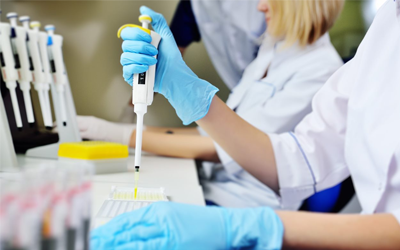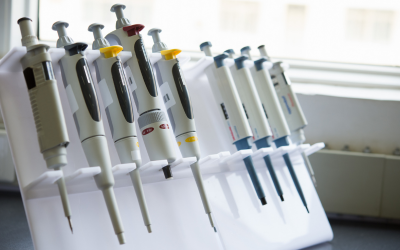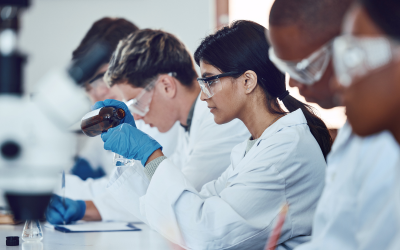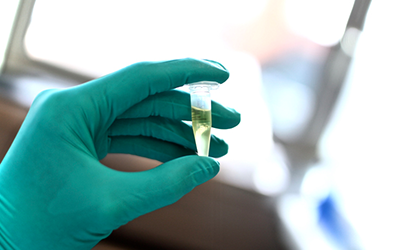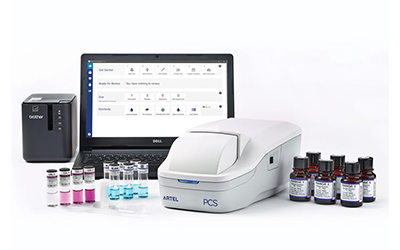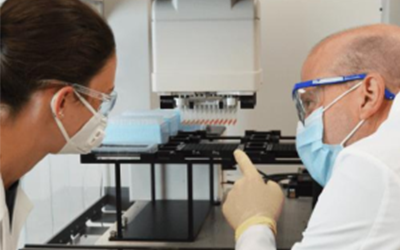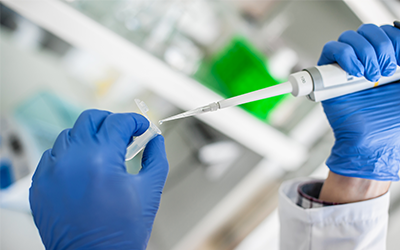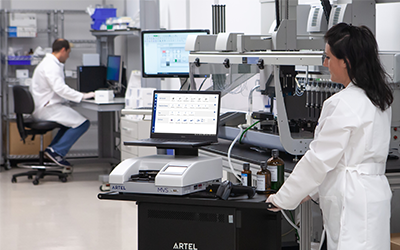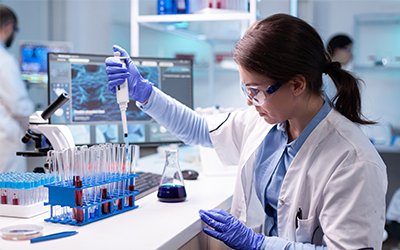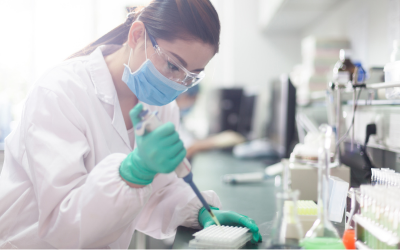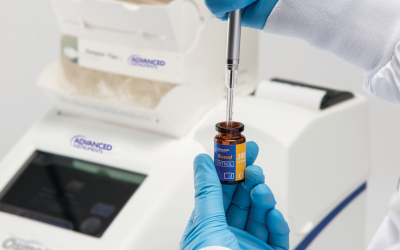Data quality and integrity are among the most important issues for any laboratory, and one of the most obvious ways to maintain quality in a laboratory setting is regular instrument calibration. Regardless of the type of measuring instrument, a traceable calibration is achieved by comparing the instrument’s performance to a standard. If the calibration of an instrument is performed out- side of the laboratory in which it is used, then this calibration must also be transferable. A transferable calibration is one that is still valid when the instrument is returned from the calibration laboratory to the user’s laboratory.1
Several calibrated items are very stable, and calibrations of these items are easily transferred (e.g., weight sets and other reference materials). Other calibrations are less transferable and will have to be performed in the user’s laboratory (e.g., calibrations of balances). For correct measurements, it is imperative that the calibrated instruments are used properly. It is therefore crucial that operators are properly trained to use all of the calibrated instruments applicable to their work.
Handheld air-displacement pipets are particularly susceptible to operator error2 and to changes in the environmental conditions in which they are being used (air and sample temperature, relative humidity, and barometric pressure).3,4 Due to these susceptibilities, pipet calibrations are poorly transferable and are best performed in the environment in which they are used. Ideally, a pipet should also be calibrated using the same tips and same technique employed by the user during everyday procedures.
The direct influence of environmental parameters and technique on pipet performance causes the overall uncertainty of volume measurements using handheld pipets to vary from location to location. Reducing those variations needs to be an important factor when considering the proper strategy for calibrating pipets. Such considerations become paramount in facilities concerned with method transfers and method validations and institutions operating facilities in more than one location.
Factors in pipet calibration
Piston-operated air-displacement pipets are ubiquitous in laboratories around the world. The accuracy and precision of pipets, and hence their total uncertainty of measurement, are susceptible to a variety of parameters. Likewise are the measurements during the pipet calibration process, i.e., the calibration method, calibration transfer standard, etc.
In general, the cumulative uncertainty pertaining to the use of any calibrated pipet depends on the following parameters: environmental conditions (temperature of sample, ambient air temperature, barometric pressure, and relative humidity), the pipet tips used, the type of calibration transfer standards, the chain of traceability (who is calibrating where), the method of calibration, and the skill and proficiency of the operator handling the pipet and calibration instruments.
Several regulatory guidelines address the topic of pipet calibration in detail.5–7 These can generally be divided into three main categories based on their focus. ISO 8655-2 Annex B provides numerical estimations of errors due to environment, equipment technique, and equipment failure. These estimates provide a basis for overall uncertainty budget calculations.
Experimental results, as well as calibration results, are directly dependent on the quality of pipet tips and other consumables used. These topics are addressed in ISO 17025 Section 4.6.2, ISO 8655-2 Annex B (Tip Design and Quality), and ASTM E1154 Section 11.2.1.
Of equal importance to all the hardware and consumables quality requirements is operator qualification. This crucial topic is addressed in FDA’s cGLP and cGMP guidelines as well as in ISO 17025 Section 5.2.1. The latter stipulates that operators should not only be qualified through education, training, and experience, but also through “demonstrated skills” in the operation of a particular instrument. The central importance of these demonstrated skills for an organization’s quality system is highlighted in the example of a case study in the second half of this article.
Sources of uncertainty
When deciding on a suitable calibration method for pipets, laboratory managers should be aware of the advantages and dis- advantages of the various methods, and how each method will affect the uncertainty budget, and hence the transferability and comparability of calibrations per- formed with each method.
Gravimetric method for calibration
To perform exact gravimetric measurements, the following parameters need to be carefully accounted for, and the results obtained corrected accordingly. Environmental variables such as temperature (T), barometric pressure (P), and relative humidity (RH) exert direct influence on the liquid density (T dependent), air buoyancy (T, P dependent), and evaporation of liquid (T, RH dependent). Furthermore, it is important to minimize air currents, since they will influence balance settling and evaporative processes. Accounting for electrostatic forces (e.g., glass versus plastic vessels) is equally important, as is choosing a balance with the appropriate resolution (as set forth in ISO 8655-6) and timing the individual aliquot additions accordingly. Using the gravimetric method, the delivered volume (VC) of pure water is described by the following equation, with Z (conversion factor to convert [mg] into [mL], accounting for air buoyancy and water density), TW (water temperature), TA (air temperature), PA (barometric pressure), W1 (weight of aliquot 1), W0 (weight before addition of aliquot 1), and e (absolute value of weight lost to evaporation during each weighing cycle [time dependent], which needs to be added to each tare addition, in [mg]).
VC= Z(TW, TA, PA) × (W1 – W0 + e)
Since the gravimetric method is extremely sensitive to this long list of variables, a skilled operator is needed to perform pipet calibrations using this method.
Photometric method for calibration
Photometric measurements are largely independent of most environmental parameters, except the temperature of the analyte in the cuvette. For accurate photometric measurements, a highly accurate photometer and highly accurate reagents must be used. The absorbance of a compound is described by the Beer-Lambert Law, in which AY is the absorbance of a solution of chromophore Y, εY is the molar extinction coefficient of Y, CY is the concentration of Y in [mol/L], and l is the pathlength of the cuvette.
AY = εY × CY × l
The molar extinction coefficient is temperature dependent, and can easily be corrected if the photometer records the temperature in its sample chamber, assuming all reagents used are well equilibrated. The most accurate photometric methods measure the absorbance of two different chromophores and apply the Beer-Lambert Law to determine the volume of an added aliquot (ratiometric photometry). The simplicity and robustness of these photometric methods remove the vast majority of variables and requirements described for the gravimetual calibration institutions within their respective jurisdiction.
Trail of traceability in pipet calibrations International Measurement System (SI)
International treaties govern the maintenance of the SI system, while national agencies such as the National Institute of Standards and Technology (NIST, Gaithersburg, MD), Physikalisch-Technische Bundesanstalt (PTB, Braunschweig, Germany), and National Physical Laboratory (NPL, Middlesex, U.K.) are responsible for maintaining the standards of the International Measurement System and disseminating them to individual calibration institutions within their respective jurisdiction.
The choice of suitable calibration transfer standards is imperative for minimizing measurement uncertainties throughout the calibration chain. Calibrated masses for balances are a commonly used transfer standard due to the ruggedness of the material (usually stainless steel), the stability toward environmental conditions, and the ease of handling and shipping. Balances do not transfer calibrations well since measurements are greatly influenced by environmental conditions, local gravity, etc. (vide supra). Pipets are not a reliable calibration transfer standard due to the large impact of environmental conditions, operator skills, and consumables (tips) on the measured results. Ideally, pipets are calibrated at the location at which they are being used.
Traceability trails
When comparing various calibration methods and calibration routes, it is essential to consider the individual laboratory’s requirements for total measurement uncertainty. In the following examples, the overall measurement uncertainty is denoted by the relative size of the blue ovals.
As shown in Figure 1, tier-1 mass laboratories (T1) compare their weights to the ones at the appropriate National Measurement Institution, rendering them traceable to the International Measurement System. Tier-2 mass laboratories (T2), in turn, compare their weights to T1 masses and extend traceability to individual calibration laboratories by comparing their weights to the T2 masses. The pipet calibration laboratory uses its traceable weights to calibrate its balances, which are used to calibrate the pipets sent to the laboratory from the various quality control (QC) laboratories (mail-in calibrations, shown on the left side in Figure 1).

Figure 1 Pipets are sent to calibration laboratories, resulting in questionable calibration transferability and large overall measurement uncertainties (relative size of blue ovals).
The traceability between the pipet calibration laboratory and the QC laboratory is denoted as a dotted line; the traceability is questionable unless it can be shown that the pipet calibration laboratory used the exact same disposable tips, technique, and environmental conditions that are found in the QC laboratory, and that no adverse conditions during shipping compromised pipet performance.
The right-hand side of Figure 1 shows the use of a higher-tier pipet calibration laboratory for mail-in calibrations. Since questionable transferability in the pipet calibration still exists, the improvement in the overall uncertainty is only relatively small. It is evident, however, that it is difficult to compare measurement uncertainties of pipets that were calibrated in different calibration laboratories, in different cities, or in locations around the globe. This fact is important for any institution validating and transferring methods at more than one location.

Figure 2 Pipets that are calibrated directly in the laboratory by gravimetric methods are subject to tighter overall measurement uncertainties than mail-in calibrations.
Figure 2 depicts a more consistent method of pipet calibration: balances located in each QC laboratory are calibrated with T1 traceable masses. Uncertainties are reduced significantly with the use of a stable calibration transfer standard (weights), and the pipets are calibrated in the environment in which they are used, by the end user, and with the appropriate tips. Potential damage to the pipets during shipment is also eliminated. Pipets calibrated using this method in different locations will per-form more similarly than those described in Figure 1. All of the inherent issues pertaining to gravimetric calibrations (vide supra), including operator skills, still persist and will influence the total uncertainty. These variations may still be too large for some method transfer and validation purposes across multiple locations, particularly when microliter volumes are being handled.

Figure 3 Accurately manufactured photometric standards are well-suited calibration transfer standards, resulting in tight overall uncertainties when used with high-quality spectrophotometers. Full comparability between calibrations is warranted due to the same source of trace-able materials.
Figure 3 shows a photometric calibration approach. Traceability of calibrations to the International Measurement System is extended to the individual QC laboratories by photometric volume transfer standards (PVTS). These standards are manufactured on equipment with trace able calibration to the International Standard (e.g., NIST), and extend traceable pipet calibrations directly to the QC laboratory. Highly accurate photometers provide a simple and robust calibration method that is largely impervious to environmental influences, allowing pipet calibrations with low total uncertainties directly in the user’s laboratory. Low uncertainties result as pipets are calibrated at their location of use, by the actual operator, with the appropriate tips, and without the potential to induce shipping damage. Calibrations are comparable from one location to another, since the same trace-able calibration standard is used in each laboratory, resulting in high confidence for method transfer and method validation tasks.
Demonstrated operator skills
Maintaining proper equipment function and selecting high-quality consumables and reagents are a few aspects of achieving the highest level of quality and confidence in laboratory data. Just as important are quality considerations pertaining to the operators using the properly calibrated, high-quality hardware. Numerous case studies have shown that opera-tor technique is one of the most frequently encountered causes of error in liquid delivery.
In the following case study, 54 quality control technicians from four leading biopharmaceutical companies were asked to pipet the same volume using the same calibrated pipet each time. The delivered volume was measured by ratiometric photometry with the PCS® Pipette Calibration System. Each technician pipetted 10 replicates, the average of which is displayed as one data point in Figures 4 and 5. First, the technicians were asked to use the same pipetting technique as they typically employ in their everyday work. The results, shown in Figure 4, clearly indicate a wide range of inaccuracy and imprecision, with many values exceeding even the most liberal tolerance limits for assays. Those operators are prone to induce significant errors to assays, solely based on the amounts of reagents they deliver with a properly calibrated pipet. After the initial skills assessment, all technicians received pipet technique training, and were subsequently asked to perform the same pipetting task once more. These post-training results are sown in Figure 5. The improvement is immediately obvious, with many operators achieving results close to the pipet manufacturer’s specifications for this volume, as indicated by the red box in Figures 4 and 5.
These results are compelling evidence that operator skills need to be assessed periodically in addition to equipment functionality. All of the participating QC technicians had the required education and were trained and experienced in their job duties as required under cGLP guidelines. Yet their pipetting skills or “demonstrated skills,” as described by ISO 17025, were never assessed and therefore never corrected. In the end, even the most accurately calibrated instrument fails to perform properly if it is used incorrectly.

Figure 4 Pipetting skills assessment of 54 QC technicians prior to pipetting technique training.

Figure 5 Pipetting skills assessment of 54 QC technicians after having received pipetting technique training.
Conclusion
Confidence in the identical performance of pipets at various locations is imperative for successful method development, method validation, and method transfer steps in any organization. Variations in pipetting from location to location are minimized when the entire liquid delivery system (pipet, tips, environment, and operator) is calibrated together, using a reliable and traceable method, directly in the user’s laboratory. Frequent calibrations of instruments are commonly acknowledged and accepted, yet frequent operator training is often overlooked. It might be easiest to look at operator training as a form of “operator calibration,” ensuring that both the instrument and user are performing in peak condition at any time. This will translate directly into strong confidence in data and reduced costs for any laboratory.
References
1. Rodrigues, G.W. Proceedings NCSL Inter-national Meeting, June 2003.
2 Vaccaro, W. Minimizing liquid delivery risk: operators as sources of error. Am. Lab. 2007, 39(17), 16–17.
3. Carle, A.B. Minimizing liquid delivery risk: laboratory environmental conditions as sources of error. Part 1: barometric pressure and thermal disequilibrium. Am. Lab. 2008, 40(2), 8–10.
4. Carle, A.B. Minimizing liquid delivery risk: laboratory environmental conditions as sources of error. Part 2: dry heat and humidity. Am. Lab. 2009, submitted for publication.
5. www.iso.org.
6. www.astm.org.
7. Regulatory documents may also be pur-chased on-line at www.webstore.ansi.org.


